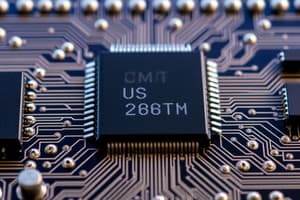Podcast
Questions and Answers
What is the purpose of the Gray code in digital systems?
What is the purpose of the Gray code in digital systems?
- To complicate the representation of binary numbers
- To speed up the digital inputs in a circuit
- To represent a sequence of numbers with only one bit changing between successive numbers (correct)
- To increase the likelihood of a digital circuit misinterpreting changing inputs
When is the situation more prone to misinterpretation in digital systems?
When is the situation more prone to misinterpretation in digital systems?
- When the input conditions remain unchanged
- When the digital system is running at slow speeds
- When only one input condition is changing at a time
- When multiple input conditions are changing at the same time (correct)
How many bits must change states at the same time when the three-bit binary number for 3 changes to 4?
How many bits must change states at the same time when the three-bit binary number for 3 changes to 4?
- Four bits
- One bit
- All three bits (correct)
- Two bits
What is the key feature of the Gray code in comparison to the binary count sequence?
What is the key feature of the Gray code in comparison to the binary count sequence?
How can binary be converted to Gray code?
How can binary be converted to Gray code?
Why has the Gray code been developed for representing a sequence of numbers?
Why has the Gray code been developed for representing a sequence of numbers?
What is the definition of one's complement in the language of arithmetic?
What is the definition of one's complement in the language of arithmetic?
How many bits must change states at the same time when the three-bit binary number for 3 changes to 4?
How many bits must change states at the same time when the three-bit binary number for 3 changes to 4?
Why has the Gray code been developed for representing a sequence of numbers?
Why has the Gray code been developed for representing a sequence of numbers?
How can binary be converted to Gray code?
How can binary be converted to Gray code?
What is the purpose of the Gray code in digital systems?
What is the purpose of the Gray code in digital systems?
When is the situation more prone to misinterpretation in digital systems?
When is the situation more prone to misinterpretation in digital systems?
What is the key feature of the Gray code in comparison to the binary count sequence?
What is the key feature of the Gray code in comparison to the binary count sequence?
What is the result when adding 1 to a binary number using one's complement arithmetic?
What is the result when adding 1 to a binary number using one's complement arithmetic?
How can one's complement be represented for negative numbers in binary?
How can one's complement be represented for negative numbers in binary?
Why is the Gray code particularly useful in rotary encoders for position sensing?
Why is the Gray code particularly useful in rotary encoders for position sensing?
What effect does electrical noise have on traditional binary representations compared to Gray code?
What effect does electrical noise have on traditional binary representations compared to Gray code?
What distinguishes one's complement from two's complement in binary arithmetic?
What distinguishes one's complement from two's complement in binary arithmetic?
What characteristic makes Gray code suitable for reducing errors in digital communication systems?
What characteristic makes Gray code suitable for reducing errors in digital communication systems?




